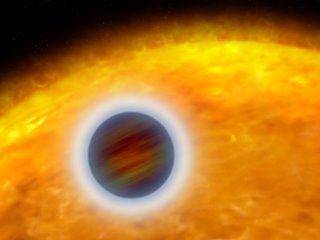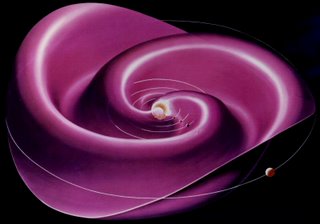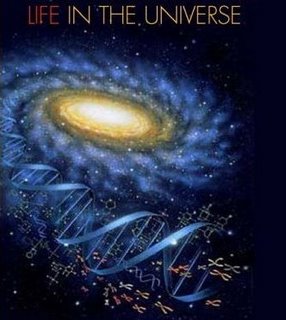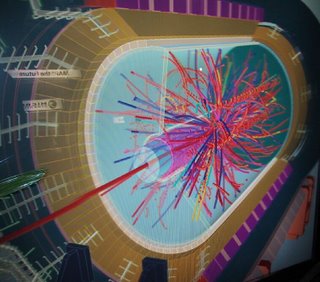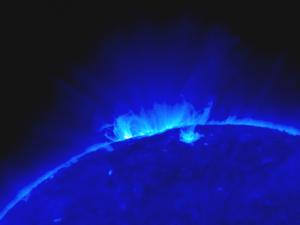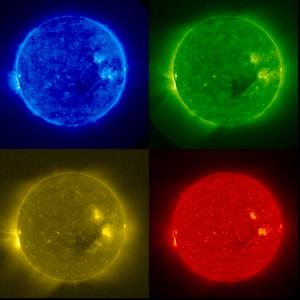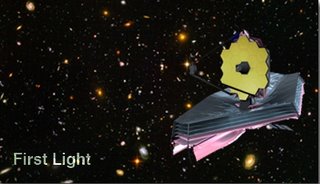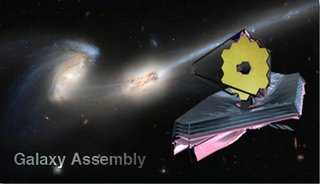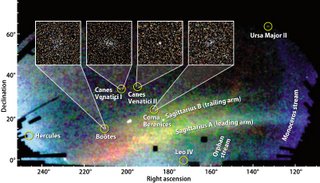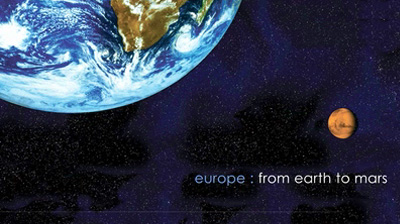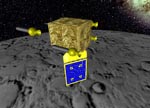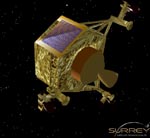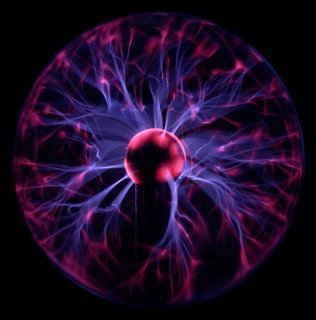
_______________________________________________________
Plasma - The Fourth State of MatterIn
physics and
chemistry, a plasma is typically an ionized gas, and is usually considered to be a distinct
state of matter in contrast to solids, liquids, and gases because of its unique properties. "
Ionized" means that at least one
electron has been dissociated from a proportion of the atoms or molecules. The free
electric charges make the plasma
electrically conductive so that it responds strongly to
electromagnetic fields.
Except near the electrodes, where there are sheaths containing very few electrons, the ionized gas contains ions and electrons in about equal numbers so that the resultant space charge is very small. We shall use the name plasma to describe this region containing balanced charges of ions and electrons.
Plasma typically takes the form of neutral gas-like clouds or charged
ion beams, but may also include dust and grains (called
dusty plasmas). They are typically formed by heating and ionizing a gas, stripping
electrons away from
atoms, thereby enabling the positive and negative charges to move freely.
Common PlasmasPlasmas are the most common
phase of matter. Some estimates suggest that up to 99% of the entire visible universe is plasma. Since the space between the stars is filled with a plasma, albeit a very sparse one (see
interstellar medium and
intergalactic space), essentially the entire volume of the universe is plasma (see
astrophysical plasmas).
Notable plasma physicist
Hannes Alfvén also noted that due to their electric charge, very small grains also behave as ions and form part of plasma (see
dusty plasmas).
The Earth's Plasmasphere (inner magnetosphere)

The Earth's "
plasma fountain", showing oxygen, helium, and hydrogen ions that gush into space from regions near the Earth's poles. The faint yellow area shown above the north pole represents gas lost from Earth into space; the green area is the aurora borealis-or plasma energy pouring back into the atmosphere.
Plasma properties are strongly dependent on the bulk (or average) parameters. Some of the most important plasma parameters are the degree of ionization, the plasma temperature, the density and the magnetic field in the plasma region.
Definition of a plasma
Although a plasma is loosely described as an electrically neutral medium of positive and negative particles, a more rigorous definition requires three criteria to be satisfied:
The plasma approximation: Charged particles must be close enough together that each particle influences many nearby charged particles, rather than just interacting with the closest particle (these collective effects are a distinguishing feature of a plasma). The plasma approximation is valid when the number of electrons within the sphere of influence (called the Debye sphere whose radius is the
Debye (screening) length) of a particular particle is large. The average number of particles in the Debye sphere is given by the
plasma parameter, Λ.
Bulk interactions: The Debye screening length (defined above) is short compared to the physical size of the plasma. This criterion means that interactions in the bulk of the plasma are more important than those at its edges, where boundary effects may take place.
Plasma frequency: The electron plasma frequency (measuring
plasma oscillations of the electrons) is large compared to the electron-neutral collision frequency (measuring frequency of collisions between electrons and neutral particles). When this condition is valid, plasmas act to shield charges very rapidly (quasineutrality is another defining property of plasmas).
Range of Plasmas Density increases upwards, temperature increases towards the right. The free electrons in a metal may be considered an electron plasma
 A candle flame.
A candle flame.
Fire can be considered to be a low temperature partial plasma.
Plasma temperaturePlasma temperature is commonly measured in
kelvins or
electronvolts, and is (roughly speaking) a measure of the thermal kinetic energy per particle. In most cases the electrons are close enough to
thermal equilibrium that their temperature is relatively well-defined, even when there is a significant deviation from a
Maxwellian energy
distribution function, for example due to
UV radiation, energetic particles, or strong
electric fields.
Because of the large difference in mass, the electrons come to thermodynamic equilibrium among themselves much faster than they come into equilibrium with the ions or neutral atoms. For this reason the ion temperature may be very different from (usually lower than) the
electron temperature. This is especially common in weakly ionized technological plasmas, where the ions are often near the
ambient temperature.
Based on the relative temperatures of the electrons, ions and neutrals, plasmas are classified as thermal or non-thermal. Thermal plasmas have electrons and the heavy particles at the same temperature i.e. they are in thermal equilibrium with each other. Non thermal plasmas on the other hand have the ions and neutrals at a much lower temperature (normally room temperature) whereas electrons are much "hotter".
Temperature controls the degree of plasma ionization. In particular, plasma ionization is determined by the electron temperature relative to the
ionization energy (and more weakly by the density) in accordance with the
Saha equation.
A plasma is sometimes referred to as being hot if it is nearly fully ionized, or cold if only a small fraction (for example 1%) of the gas molecules are ionized (but other definitions of the terms hot plasma and cold plasma are common). Even in a "cold" plasma the electron temperature is still typically several thousand degrees Celsius. Plasmas utilized in plasma technology ("technological plasmas") are usually cold in this sense.

_______________________________________________________
The remnant of Tycho's Supernova, a huge ball of expanding plasma. The blue outer shell arises from X-ray emission by high-speed electrons.Although the underlying equations governing plasmas are relatively simple, plasma behaviour is extraordinarily varied and subtle: the emergence of unexpected behaviour from a simple model is a typical feature of a
complex system. Such systems lie in some sense on the boundary between ordered and disordered behaviour, and cannot typically be described either by simple, smooth, mathematical functions, or by pure randomness. The spontaneous formation of interesting spatial features on a wide range of length scales is one manifestation of plasma complexity.
Quasineutrality of a plasma requires that plasma currents close on themselves in electric circuits. Such circuits follow
Kirchhoff's circuit laws, and possess a
resistance and
inductance. These circuits must generally be treated as a strongly coupled system, with the behaviour in each plasma region dependent on the entire circuit. It is this strong coupling between system elements, together with nonlinearity, which may lead to complex behaviour.

_____________________________________________________
A solar coronal mass ejection blasts plasma throughout the solar system.Electrical circuits in plasmas store inductive (magnetic) energy, and should the circuit be disrupted, for example, by a plasma instability, the inductive energy will be released as plasma heating and acceleration. This is a common explanation for the heating which takes place in the
solar corona. Electric currents, and in particular, magnetic-field-aligned electric currents (which are sometimes generically referred to as
Birkeland currents), are also observed in the Earth's aurora, and in plasma filaments.
_______________________________________________________
_______________________________________________________
Famous Quotes:Essentially the entire volume of the Universe is Plasma._______________________________________________________
_______________________________________________________
Labels: Plasma
